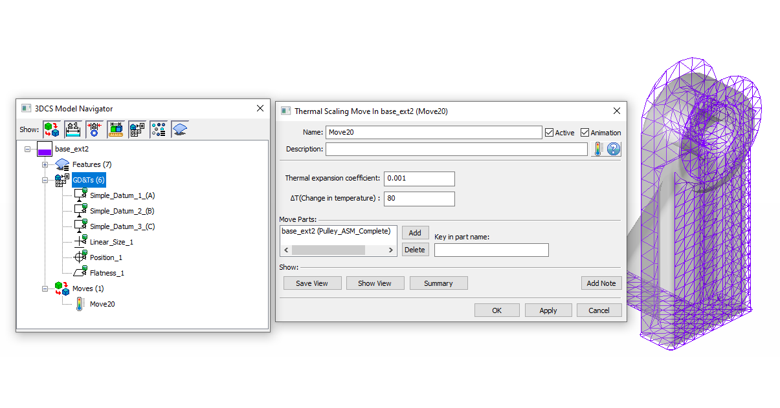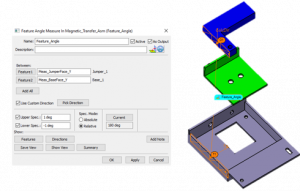
DCS launches V7.9 of 3DCS Variation Analyst with two webinars to show the new features and updates and how to apply them to Tolerance Analysis Digital Twins
— Dave Johnson, 3DCS Product Manager
AUBURN HILLS, MICHIGAN, USA, June 7, 2022 /EINPresswire.com/ — Dimensional Control Systems (DCS), part of SANDVIK Metrology Group, has launched their major release of 3DCS Variation Analyst Software for 2022. The new update brings with it more than fifteen new features, as well as quality of life improvements, and feature updates. To demonstrate all of the new major features, DCS is hosting two webinars to walk through the new features and how to use them.
3DCS Variation Analyst is a CAD integrated simulation software used by leading manufacturers in the aerospace, automotive, medical device, electronics and machinery industries to create Digital Twins in order to simulate assembly processes and tolerance stacks using 3D models.
“This new version of 3DCS provides a number of key features requested by our customers,” said Dave Johnson, 3DCS Product Manager. “As part of our ongoing mission to provide the best tools for our clients, we have taken their feedback and incorporated it into our software tools in order to offer the best experience and analysis possible for their Digital Twins.”
Part 1 of the 3DCS Version 7.9 Webinar Series (On-Demand)
Part 1 covers the first seven major features:
1. V53DX with Model Navigator
2. 3DCS Tree Hiding Empty Parts
3. Model Navigator Branch Tree
4. Simulation Convergence
5. Normality Testing
6. Thermal Scaling
7. Improved Iteration Move
CATIA V5 & 3DEXPERIENCE with Model Navigator
3DCS for CATIA V5 (CAA V5 Based) and the 3DEXPERIENCE are being updated with new Model Navigators to make it easier to find your parts, features, and MTM’s. We’ll be showing the new interface and how it can help you organize your models to improve model navigation.
3DCS Tree Hiding Empty Parts
Ever have a ton of parts in a product (like an aircraft wing or automotive assembly)? Wouldn’t it be nice if you could just hide all the parts you aren’t working on so that it would be easier to focus on what you are working on? Check out this new quality of life feature to help you focus on what you’re working on, without having to constantly scroll through all of your parts and features.
Model Navigator & Branch Tree
Reorganize your model to help focus on key groupings, or hone in on sub-assemblies and components. We’re trying to make it easier to see what you’re working on, and not have it buried in your model.
Simulation Convergence
3DCS Convergence is designed to help the user determine how many samples to run (Monte Carlo) to ensure the results are within a predefined confidence interval.
Normality Testing
The consistency of Normality Testing has been improved in this release. Come see what we’ve done!
Thermal Scaling
How does temperature affect your components? Thermal Scaling adds an easy-to-use function to quickly see how your parts and assemblies might be affected by Temperature giving you insight into your risks of non-conformance.
Improved Iteration Move
The Iteration Move allows users to simulate stepped processes for assembly. New updates to the Iteration Move provide tools to tackle advanced setups like:
— Bisection
Improved convergence speed compared to the previous method. Also suitable for functions that only have one-sided values, e.g., true distance.
— Bracketing Secant (Regula Falsi)
It is usually faster than Bisection because of the way it calculates the convergence steps (storing the previous two values).
Part 2 of the 3DCS Version 7.9 Webinar Series (June 23rd)
Part 2 of the webinar set covers eight more features:
1. Feature Angle Measure
2. GD&T Help
3. Tree Linking Wizard, Minimum linking rules
4. Feature Linking Wizard
5. Dll Action Tree
6. Contributor Analysis Enhancement
7. DVM & MVM Enhancement
8. Google Suite Support
Watch the first webinar on-demand and register for the second, coming up on June 23rd, all in one place. Click here to learn more and see what’s new in 3DCS simulation software – https://mkt.3dcs.com/new-3dcs-major-release-webinars-2022.
About Dimensional Control Systems
Dimensional Control Systems Inc. (DCS) based in Troy, Michigan, USA is focused on the methodology of Dimensional Engineering. DCS develops two software solutions that are combined with services to provide manufacturing companies the world over with improved design and quality visibility. With over 50 years of Dimensional Engineering background, DCS continuously strives to exceed our customer’s expectations for world-class Variation Analysis and Quality Management System (QMS) software and services. Learn more at 3dcs.com.
Benjamin Reese
Dimensional Control Systems
+1 248-269-9777
email us here
3DCS Variation Analyst – New Version 7.9 – Thermal Scaling for Quickly Adding Deformation to Digital Twins



